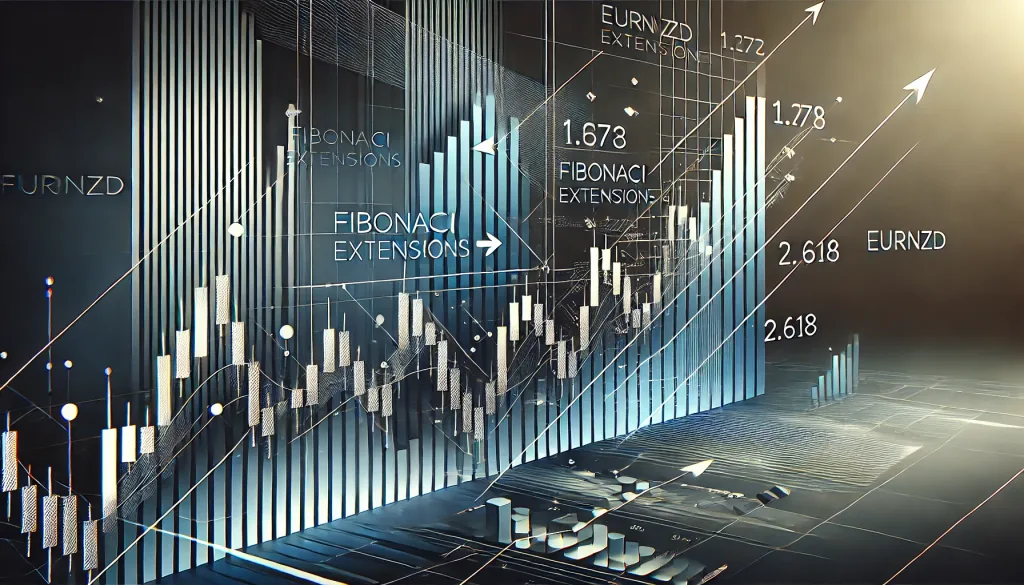Unlocking Fibonacci Extension Secrets for EURNZD Success

The Hidden Power of Fibonacci Extensions
Imagine discovering a tool so precise, it’s like having a crystal ball for market trends. Enter Fibonacci extensions—a game-changer for traders who want to ride the waves of EURNZD with confidence. Let’s decode this underrated tool, dive into its intricacies, and uncover how it can supercharge your trading game.
But first, picture this: you’re standing at a buffet, overwhelmed by choices. Much like trading, it’s easy to fill your plate with strategies and end up with analysis paralysis. Fibonacci extensions act like a cheat sheet, guiding you to the tastiest (and most profitable) picks. Let’s dive in.
What Are Fibonacci Extensions and Why Should You Care?
At its core, Fibonacci extensions are mathematical ratios applied to price movements. These levels help traders identify potential support and resistance zones beyond the standard retracements. Think of them as your GPS in the Forex jungle, pinpointing where the EURNZD pair might stall or reverse.
Quick Recap: Fibonacci extensions expand on the Fibonacci retracement tool, projecting potential profit targets by using key ratios like 1.272, 1.618, and 2.618.
Why EURNZD?
EURNZD is a volatile pair with frequent, sharp movements—perfect for leveraging Fibonacci extensions. Whether you’re scalping or swinging, these extensions provide clarity in chaos. Plus, with the Euro and New Zealand Dollar often influenced by contrasting economic factors, opportunities for breakout trades abound.
The 3-Step Formula for Using Fibonacci Extensions on EURNZD
- Identify the Impulse Move: Start by spotting a strong, directional move on the chart. This could be a bullish rally or a bearish drop.
Pro Tip: Use higher timeframes (like H4 or Daily) to identify significant impulse moves for better accuracy.
- Apply the Fibonacci Tool: Select the Fibonacci extension tool in your trading platform. Anchor it to the start and end of the impulse move, and then drag it to the retracement point.
Ninja Insight: Look for confluence between Fibonacci levels and other technical indicators like moving averages or pivot points.
- Set Target Levels: Key levels to watch are 1.272, 1.618, and 2.618. These often act as magnets for price action. Use them to set realistic profit targets.
Pro Tip: Monitor market sentiment and economic news affecting the Euro or New Zealand Dollar to validate your setups.
Why Most Traders Get It Wrong (And How to Avoid It)
Let’s be real: many traders misuse Fibonacci extensions. They slap it on a chart without understanding context, leading to frustration and losses. Here’s how to sidestep common pitfalls:
- Mistake 1: Ignoring Trend Context Extensions work best in trending markets. Applying them in choppy conditions is like trying to row a boat on dry land.
- Mistake 2: Overloading with Indicators Simplicity wins. Combine Fibonacci extensions with one or two complementary tools—not a dozen.
- Mistake 3: Neglecting Risk Management A golden rule: never risk more than 2% of your account on a single trade. Even the best analysis can go sideways.
Real-World Example: EURNZD in Action
Let’s bring this to life with a recent EURNZD setup:
- Impulse Move: On the H4 chart, EURNZD surged from 1.7200 to 1.7500, followed by a pullback to 1.7350.
- Extension Levels: Using the Fibonacci tool, key levels of 1.272 (1.7630) and 1.618 (1.7770) were plotted.
- Outcome: Price rallied to 1.7630 before stalling, validating the 1.272 level as a profit target.
Lesson: Combining Fibonacci extensions with support zones and candlestick patterns enhanced this trade’s success probability.
Underground Trends: The Next-Level Twist
Here’s an insider tip: pair Fibonacci extensions with volume analysis. High volume at extension levels often signals strong institutional interest, giving your trades extra validation.
Another twist? Use harmonic patterns like the Butterfly or Gartley alongside extensions for pinpoint accuracy. These patterns naturally align with Fibonacci levels, offering a double dose of confidence.
Elite Tactics for EURNZD
- Dynamic Confluence: Look for overlapping Fibonacci levels from different impulse moves. This creates a “hot zone” of high probability.
- Time Factor: Combine Fibonacci extensions with time cycles to predict not just price but timing of reversals or breakouts.
- Alert System: Use trading tools to set alerts at key Fibonacci levels. This ensures you never miss an opportunity while sipping your morning coffee.
The Fibonacci Edge
Fibonacci extensions are more than just lines on a chart; they’re your secret weapon for navigating the EURNZD pair with precision. By mastering their application and avoiding common mistakes, you’ll trade with confidence and clarity.
Ready to level up? Dive into exclusive insights and tools at StarseedFX to transform your trading journey.
—————–
Image Credits: Cover image at the top is AI-generated
PLEASE NOTE: This is not trading advice. It is educational content. Markets are influenced by numerous factors, and their reactions can vary each time.

Anne Durrell & Mo
About the Author
Anne Durrell (aka Anne Abouzeid), a former teacher, has a unique talent for transforming complex Forex concepts into something easy, accessible, and even fun. With a blend of humor and in-depth market insight, Anne makes learning about Forex both enlightening and entertaining. She began her trading journey alongside her husband, Mohamed Abouzeid, and they have now been trading full-time for over 12 years.
Anne loves writing and sharing her expertise. For those new to trading, she provides a variety of free forex courses on StarseedFX. If you enjoy the content and want to support her work, consider joining The StarseedFX Community, where you will get daily market insights and trading alerts.
Share This Articles
Recent Articles
The GBP/NZD Magic Trick: How Genetic Algorithms Can Transform Your Forex Strategy
The British Pound-New Zealand Dollar: Genetic Algorithms and the Hidden Forces Shaping Currency Pairs
Chande Momentum Oscillator Hack for AUD/JPY
The Forgotten Momentum Trick That’s Quietly Dominating AUD/JPY Why Most Traders Miss the Signal
Bearish Market Hack HFT Firms Hope You’ll Never Learn
The One Bearish Market Hack High Frequency Traders Don't Want You to Know The

